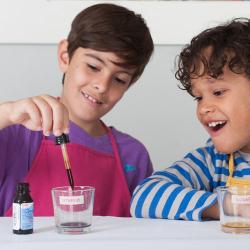Source Institutions
Source Institutions
Add to list Go to activity
Activity link broken? See if it's at the internet archive

Some animals can swallow food whole, but humans have to chew. In this activity, learners will investigate what saliva does chemically to food before we even swallow. Learner will examine how their own saliva affects a mashed-up cracker by using iodine to differentiate sugar and starch. Experiment can also be used on other foods like breakfast cereal. Step-by-step instructions are included with photos. Activity guide includes a "What's going on?" explanation and connections to relevant science concepts like enzymes in saliva, digestion, and salivary glands.
- 10 to 30 minutes
- 30 to 45 minutes
- $5 - $10 per group of students
- Ages 6 - adult
- Activity, Experiment/Lab Activity
- English
Quick Guide
Materials List (per group of students)
- pinch of cornstarch
- pinch of granulated sugar
- cracker
- resealable plastic bad (sandwich size)
- cup of water
- 4 small spoons
- 4 small cups
- set of measuring spoons
- small bottle of iodine
- masking tape
- marker
Subjects
-
Life Sciences
-
Human Body
- Digestion
-
Human Body
-
Physical Sciences
-
Chemistry
- Chemical Reactions
- Chemistry of Life
-
Chemistry
Informal Categories
- Food and Cooking
Audience
Learning styles supported:
- Involves hands-on or lab activities
Other
This resource is part of:
Access Rights:
- Free access
By:
Source Collection
- DIY Science Apps
Rights:
- , The Regents of the University of California, 2015
Funding Source:
- National Institutes of Health Science Education Partnership Award, 5R25OD010543-02
